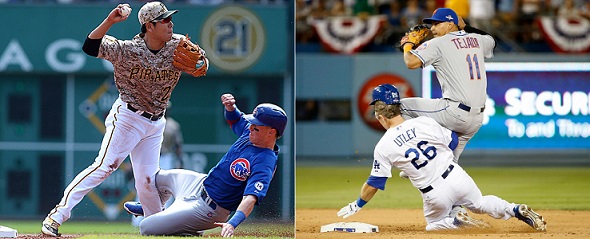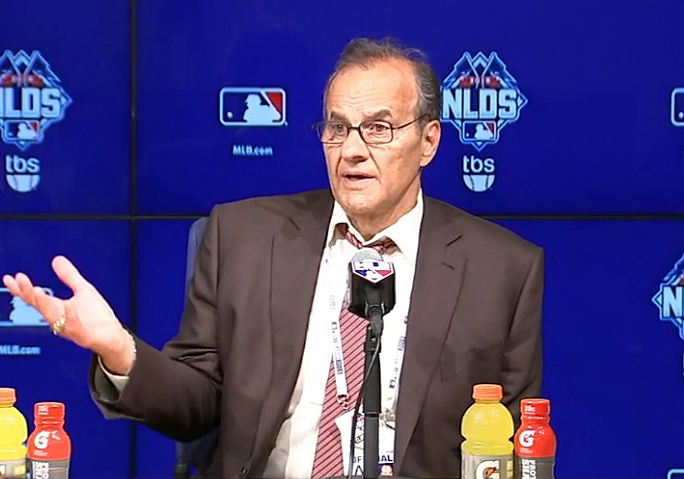Sometime between Cubs left fielder Chris Coglan’s takeout slide of Pirates shortstop Jung-ho Kang on September 17 and Dodgers utility infielder Chase Utley’s takeout slide of Mets shortstop Ruben Tejada in Game-2 of the NLDS on October 10, Major League Baseball decided that they needed to address the century-old rule pertaining to takeout slides or – more specifically – the rule as to what baserunners can and cannot do while trying to break up a double play. Unfortunately, it took serious injuries to Kang and Tejada to get to this point.

Serious leg injuries to Pirates infielder Kang and Mets infielder Ruben Tejada have prompted MLB to make some much-needed changes to the takeout slide and neighborhood play rules. (Photo credit – Charles LeClaire & Sean M. Haffey)
For old-school baseball traditionalists – of which I am one – any proposed rule change causes me to shudder. Our basic philosophy is that, hey, we’ve dong it this way for 146 years, why change it now. And while this “If it ain’t broke, don’t fix it” mentality is designed to preserve and protect the very lifeblood of our national pastime, the bottom line is that the takeout slide rule (and the neighborhood play rule) are as broken as Jung-ho Kang’s left tibial plateau and and Ruben Tejada’s right fibula.
The current rule governing aggressive takeout slides is covered under MLB Rule 7.09(f) which reads:
If, in the judgment of the umpire, a batter-runner willfully and deliberately interferes with a batted ball or a fielder in the act of fielding a batted ball, with the obvious intent to break up a double play, the ball is dead; the umpire shall call the batter-runner out for interference and shall also call out the runner who had advanced closest to the home plate regardless where the double play might have been possible. In no event shall bases be run because of such interference.
Another existing rule in this regard is MLB Rule 6.05(m) which reads:
A preceding runner shall, in the umpires judgment, intentionally interfere with a fielder who is attempting to catch a thrown ball or to throw a ball in an attempt to complete any play:
Rule 6.05(m) Comment: The objective of this rule is to penalize the offensive team for deliberate, unwarranted, unsportsmanlike action by the runner in leaving the baseline for the obvious purpose of crashing the pivot man on a double play, rather than trying to reach the base. Obviously this is an umpires judgment play.
As noted, both of these rules are judgment calls by the umpire(s) which, of course, makes them subject to their interpretation and opinion, as they should be. Where the problem arises is defining what a good, hard, legal slide is and one that goes a little too far and becomes a willful and deliberate interference of a fielder with the obvious intent to break up a double play.
The rule of thumb – which clearly goes beyond 7.09(f) and 6.05(m) – has long been that if the runner can actually touch the bag while sliding, anything goes. The reality, however, is that with a fully stretched out arm or leg, the sliding runner can be as much as two yards (or more) off the bag and adjacent to it with the sole intent of interfering with the fielder turning two. But here again, it’s been done this way for over a hundred years, so why mess with it, say the old-school traditionalists.
So what does any of this have to do with the Arizona Fall League?
As noted above, MLB was already looking into modifying the takeout slide and neighborhood play rules before the unfortunate Utley/Tejada incident and had already planned on ‘testing the waters’ during this season’s AFL which, ironically, kicked off its season on Tuesday, October 13.
Although it was apparently supposed to be kept a secret, MLB Chief Baseball Officer Joe Torre spilled the beans during a Q and A session following Game-2 of the NLDS specifically to address the Utley/Tejada incident.
“We’re always looking to protect players. I mean, we have the crash rule at the plate and stuff like that. It’s a concern,” Torre said. “If there’s something – and what we’re doing in the Fall League, and I don’t know if I’m supposed to say this – but in the Fall League we’re having the players work on sliding directly into the bag, just to see how that works and stuff.”
When asked why the AFL, Torre elaborated.
“This is where we can experiment with stuff. That’s where we put the [pitching] clocks in and stuff for speeding the game up,” explained the Hall of Fame manager.

MLB Chief Baseball Officer Joe Torre told the media that a pending rule change will be tested during the Arizona Fall league, which kicked off on Tuesday afternoon. (Video capture courtesy of TBS)
Although it will undoubtedly take a while to evaluate the results and data from the 2015 AFL, the one very obvious area of concern for the offensive team is, if runners are going to be required to slide directly into the bag thereby giving them no chance whatsoever to break up a double play, then any new rule change had better completely eliminate the neighborhood play and require the fielder to actually make contact with the bag instead of allowing the ‘close enough’ plays to continue.
The neighborhood play, which was adopted solely for the purpose of trying to eliminate (or at least reduce) exactly what happened to Kang and Tejada and hundreds of others over the years, but it will no longer be necessary if runners are no longer allowed to take them out and are required to slide directly to the bag. You certainly can’t give an unfair advantage to one by taking away the advantage of the other.
Will it work? Who knows. In theory it should – again, so long as they also eliminate the neighborhood play. At the very least it will more than likely reduce the number of leg injuries sustained by middle infielders which, of course, is the very intent of the proposed rule change.




 October 13th, 2015 at 12:50 pm
October 13th, 2015 at 12:50 pm  by Ron Cervenka
by Ron Cervenka  Posted in
Posted in 
